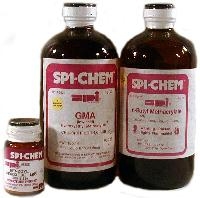SPI-Chem Low Acid GMA TEM Kit, 750g Total Kit Vol.,(2 x DG-Butyl Methacrylate & Benzoyl Peroxide)
| Quantity | Price |
|---|---|
| 1 to 9 | $94.70 |
| 10 and up | $85.23 |
| Availability | Contact for Availability |
|---|---|
| Item | 02630-AB |
Kit contains (approximately 750 gms of resin total):
Water soluble "Low Acid" GMA embedding
Glycol methacrylate (GMA), otherwise known as 2-hydroxyethyl methacrylate, is the embedment of choice for both TEM and LM applications, particularly for hydrated specimens with sensitive "antigenic sites".
A "one size fits all" approach does not work so well for GMA embedding because for TEM applications, one needs thin sections, and therefore a "harder" block is needed, but for LM, one needs thicker sections, and therefore, the need for a "softer" block. Therefore instead of offering a single kit with an intermediate hardness (leaving no one with the optimum hardness), SPI offers two different kits, one specifically optimized for TEM (to yield a harder block) and another one optimized for LM (to yield a softer block).
Furthermore, there are a number of advantages of using "low acid" instead of the more common and lower cost "technical grade" GMA that is generally provided in kits not specifically being labelled as "low acid". For example, at the LM level, the use of "low acid" GMA results insignificantly lower background staining. And at the TEM level, the absence of the acid derivative of the monomer results in less interaction and problems with curing when high lipids levels are present.
For TEM applications, the SPI-Chem Low Acid embedding kits can be used to infiltrate biological tissue and preserve and observe fine structure not previously subjected to solvent dehydrations. The LM, GMA far outdistances paraffin or other embedding methods for resolution, clarity, and contrast in observing thin sections.
For immunogold work, especially in the case of sensitive antigenic sites, the ability to avoid an alcohol dehydration step altogether represents a major advantage. The monomer acts as its "own dehydrator", and in fact won't even work at all if at least some water is present. Often times, one gets superior results when the sample is not subjected to any alcohol dehydration.
So far as we know, the SPI-Chem Low Acid GMA kits are compatible with all reported staining methods and procedures. However, the first time user should also recognize that the learning curve for using GMA is probably a bit longer than for other resin systems. Because of that, we are accumulating a listing of "Frequently Asked Questions" (FAQ's) about the use of low acid GMA.
Infiltration of tissue and monomer can be performed at room temperature or down to -16° C. The GMA monomer has a viscosity like that of water, so there are some applications where GMA is the embedment of choice because it is the only monomer with low enough viscosity to infiltrate difficult to infiltrate samples. For immunogold work, the resulting GMA polymer can be "etched" and there are published techniques for doing this.
Even materials science researchers have found unique applications for SPI-Chem Low Acid GMA when wet polymeric systems, such as for work on reverse osmosis membranes is being done, because no other system seems to be able to resolve the pores in the membranes. This unique yet versatile resin system also has found applicability with biomaterials researchers, especially in conjunction with implant retrieval studies.
Check out some of the many references citing the use of Low Acid GMA to obtain superior results.
Presence of inhibitors:
The SPI-Chem Brand GMA monomer is supplied with the methacrylic acid originally present substantially removed but with small amounts of inhibitors present, to inhibit spontaneous polymerization during synthesis and storage. This inhibitor need not be removed before use. The benzoyl peroxide catalyst as supplied is provided in granular form.
An understated potential safety risk:
We are addressing now the cured block, something that to most people is about as inert of a material as one will find. But the standard practice in many laboratories is to use a small jeweler's (or even a small hack) saw to cut the block down to the right size, sometimes even to shape it. We want to address the dust that is generated and how its exposure can and should be minimized.

